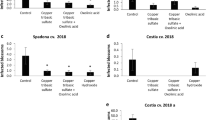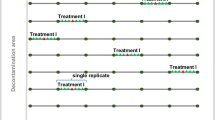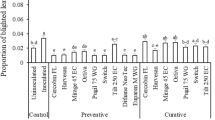Abstract
Fire blight of apples (Erwinia amylovora) can be a serious disease depending on production area and year. Bloom is the most frequent starting point for infection and the primary focus for sprays which can prevent infection, or of growth regulators such as prohexadione-Ca (ProCa) to limit spread. Because of the sporadic cases, many growers opt to forego bloom sprays when disease pressure is low. When symptoms do appear, quickly pruning out affected branches is currently the most effective control measure. Our goal was to determine if ProCa applied when symptoms appear, instead of during bloom when infection risks are predicted, could be used to limit disease spread, and if this would interact with summer symptom removal. The study was carried out in 2018 and 2019 at the IRDA orchard in Saint-Bruno-de-Montarville, Québec. Plots inoculated during bloom were allocated to treatments in which diseased branches were either pruned during summer or only in winter, and trees sprayed with ProCa starting at bloom, when symptoms appeared, or not. Potential for disease progression was assessed by inoculating shoots and rating them for disease severity and ooze production. Significantly less wood was removed from trees pruned during the summer as opposed to winter, but total yield was reduced. ProCa had no effect on the amount of dead wood pruned, but still reduced disease severity. We found that ProCa reduced ooze on inoculated shoots and that post symptom timing was as effective as the bloom spray. Delaying sprays until symptoms appear could become an alternative strategy to reduce summer spread of fire blight.





Similar content being viewed by others
References
Aćimović SG, Higgins E, Meredith CL (2019) Effective post-infection programs of prohexadione-calcium for reducing shoot blight and preventing fire blight canker initiation on apple wood with cost-benefit analysis. New York Fruit Quarterly 27(2):25–31
Apogee® (2015) Plant growth regulator registration 28042. https://pr-rp.hc-sc.gc.ca/ls-re/lbl_detail-eng.php?p_disp_regn=%2728042%27&p_regnum=28042
Bates D, Mächler M, Bolker B, Walker S (2015) Fitting Linear Mixed-Effects Models Using lme4. J Stat Softw 67:1–48
Beer SV (1979) Fireblight Inoculum: Sources and Dissemination. EPPO Bull 9:13–25
Bubán T, Földes L, Fekete Z, Rademacher W (2004) Effectiveness of the resistance inducer prohexadione-Ca against fireblight in shoots of apple trees inoculated with Erwinia amylovora. EPPO Bull 34:369–376
Charest J, Philion V (2006) Apogee: La fin des vergers touffus, tout flammes. Bull. Inf. Pommier Réseau Avertissements Phytosanitaires. Gouv Qué Ministère Agric Pêch Aliment. https://www.agrireseau.net/Rap/documents/b03pom06.pdf
Christensen RHB (2019) ordinal—Regression Models for Ordinal Data. R package version 2019 4–25. http://www.cran.r-project.org/package=ordinal/
Costa G, Sabatini E, Spinelli F, Andreotti C, Bomben C, Vizzotto G (2004) Two years of application of prohexadione-ca on apple: effect on vegetative and cropping performance, fruit quality, return bloom and residual effect. Acta Hortic 653:35–40. https://doi.org/10.17660/ActaHortic.2004.653.3
Cox KD, Wallis A, Carroll J (2019) Managing fire blight in 2019. Scaffolds Fruits J 28(6):1–6
Fernando WGD, Jones AL (1998) Prohexadione calcium-a tool for reducing secondary fire blight infection. Acta Hortic. 489, 597–600. https://doi.org/10.17660/ActaHortic.1999.489.103
Forshey CG, Elfving DC (1989) The relationship between vegetative growth and fruiting in apple trees. Hortic Rev 100:229–287
Forshey CG, Elfving DC, Stebbins RL (1992) Training and pruning apple and pear trees. Am Soc Hortic Sci 162 pp. ISBN:0-9615027-1-1
Greene DW (2008) The Effect of Repeat Annual Applications of prohexadione–calcium on Fruit Set, Return Bloom, and Fruit Size of Apples. HortScience 43:376–379
Harrison XA, Donaldson L, Correa-Cano ME, Evans J, Fisher DN, Goodwin CED, Robinson BS, Hodgson DJ, Inger R. 2018. A brief introduction to mixed effects modelling and multi-model inference in ecology. PeerJ 6:e4794 https://doi.org/10.7717/peerj.4794
Johnson KB, Temple TN (2013) Evaluation of Strategies for Fire Blight Control in Organic Pome Fruit Without Antibiotics. Plant Dis 97:402–409
Kunz S, Donat C (2014) Field results for the efficacy of fire blight control agents in the last fifteen years in germany. Acta Hortic 1056:101–106. https://doi.org/10.17660/ActaHortic.2014.1056.13
Loi sur la protection sanitaire des cultures (2008) http://www2.publicationsduquebec.gouv.qc.ca/dynamicSearch/telecharge.php?type=5&file=2008C16F.PDF
McGrath MJ, Koczan JM, Kennelly MM, Sundin GW (2009) Evidence that prohexadione-calcium induces structural resistance to fire blight infection. Phytopathology 99:591–596
McRoberts N, Hall C, Madden LV, Hughes G (2011) Perceptions of Disease Risk: From Social Construction of Subjective Judgments to Rational Decision Making. Phytopathology 101:654–665
Norelli JL, Jones AL, Aldwinckle H, S. (2003) Fire blight management in the twenty-first century: using new technologies that enhance host resistance in apple. Plant Dis 87:756–765
Philion V (2015) Le feu bactérien : stratégies de lutte. In Guide de référence en production fruitière intégrée à l’intention des producteurs de pommes du Québec, Institut de recherche et de développement en agroenvironnement, Québec, QC. https://reseaupommier.irda.qc.ca/?p=6932
Philion V, Trapman M (2011) Description and preliminary validation of RIMpro-Erwinia, a new model for fire blight forecast. Acta Hortic. XII International Workshop on Fire Blight 896:307–317. https://doi.org/10.17660/ActaHortic.2011.896.43
Pinheiro J, Bates D, DebRoy S, Sarkar D, R Core Team (2019) nlme: Linear and Nonlinear Mixed Effects Models. https://CRAN.R-project.org/package=nlme
R Core Team (2019) R: A Language and Environment for Statistical Computing. Vienna, Austria: R Foundation for Statistical Computing. https://www.R-project.org/
Schupp JR, Rosenberger DA, Robinson TL, Aldwinkle H, Norelli J, Porpiglia PJ (2002) Post-symptom sprays of prohexadione-calcium affect fire blight infection of “Gala” apple on susceptible or resistant rootstocks. Hort Sci 37:903–905
Smith TJ (2013) Fire blight: barriers to control in the past and present/future control strategies. Acta Hortic. XIII International Workshop on Fire Blight 1056:29–38. https://doi.org/10.17660/ActaHortic.2014.1056.1
Smith TJ, Pusey PL (2011) Cougarblight 2010, a significant update of the Cougarblight fire blight infection risk model. Acta Hortic 896:331-336. https://doi.org/10.17660/ActaHortic.2011.896.45
Toussaint V, Philion V (2008) Natural epidemic of fire blight in a newly planted orchard and effect of pruning on disease development. Acta Hortic 793:313-320. https://doi.org/10.17660/ActaHortic.2008.793.46
Triloff P, Knoll M, Lind K, Herbst E, Kleisinger S (2013) Low-Loss Spray Application - The scientific basis. In Julius-Kühn-Archiv 439:127–134. https://doi.org/10.5073/jka.2012.439.018. https://ojs.openagrar.de/index.php/JKA/article/view/2354
Turecheck WW, Rosenberger D, Aldwinckle HS, Schupp JR, Robinson T (2001) Using apogee to help manage fire blight. Scaffolds Fruits J 10. http://www.scaffolds.entomology.cornell.edu/2001/5.7_disease.html
Turechek WW, Biggs AR (2015) Maryblyt v. 7.1 for Windows: an improved fire blight forecasting program for apples and pears. Plant Health Prog 16(1):16-22. https://doi.org/10.1094/PHP-RS-14-0046
Vanneste JL (2000) Fire blight: the disease and its causative agent. CABI Publishing
Venables WN, Ripley BD (2002) Modern Applied Statistics with S. Fourth. New York: Springer. http://www.stats.ox.ac.uk/pub/MASS4
Wallis A, Cox K (2019) Management of fire blight using pre-bloom application of prohexadione-calcium. Plant Dis 104(4):1048-1054. https://doi.org/10.1094/PDIS-09-19-1948-RE
Wickham H, Averick M, Bryan J, Chang W, McGowan LD, François R et al (2019) Welcome to the tidyverse. J Open Source Softw 4:1686
Yoder KS, Miller SS, Byers RE (1999) Suppression of fire blight in apple shoots by prohexadione-calcium following experimental and natural inoculation. Hort Sci 34:1202–1204
Zwet T, Keil HL (1979) Fire blight, a bacterial disease of Rosaceous plants. Agric. Handb. Sci. Educ, Adm
Acknowledgments
This project would not have been possible without the summer student trainee program and staff of the IRDA research orchard. This project received financial support from the ministère de l’Agriculture, des Pêcheries et de l’Alimentation du Québec (MAPAQ), as part of a special initiative “Développement et diffusion des connaissances sur les stratégies de gestion de la brûlure bactérienne dans les vergers de pommiers.” The multinational apple forecast integration association coordinated the work.
Author information
Authors and Affiliations
Corresponding author
Ethics declarations
Conflict of interest
Vincent Philion and Valentin Joubert declare they have no conflict of interest. This article does not contain any studies with human participants or animals performed by any of the authors.
Additional information
Publisher’s Note
Springer Nature remains neutral with regard to jurisdictional claims in published maps and institutional affiliations.
Rights and permissions
About this article
Cite this article
Philion, V., Joubert, V. Use of a growth regulator (prohexadione-Ca) and summer pruning as post symptom rescue treatments following a fire blight infection during bloom. J Plant Pathol 103 (Suppl 1), 163–174 (2021). https://doi.org/10.1007/s42161-021-00805-5
Received:
Accepted:
Published:
Issue Date:
DOI: https://doi.org/10.1007/s42161-021-00805-5




